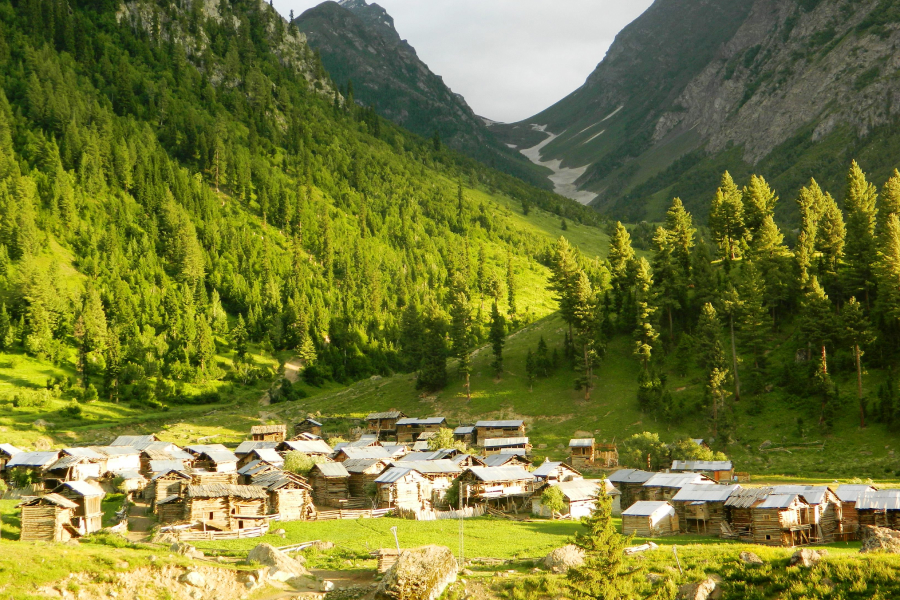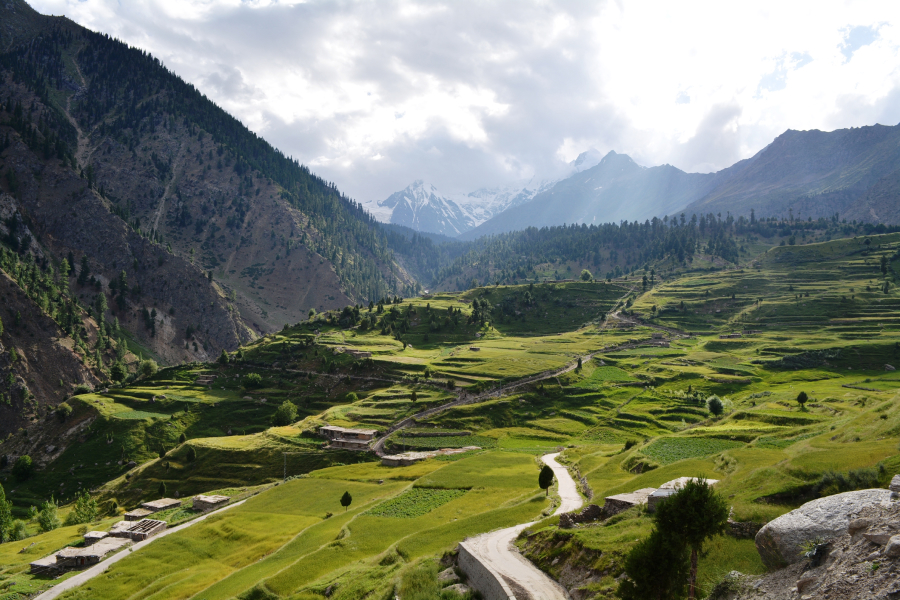Nestled amidst the majestic peaks of the Karakoram Mountains,Astore Valley is a hidden gem in Gilgit-Baltistan, Pakistan. This pristine valley, known for its breathtaking landscapes, charming villages, and rich cultural heritage is a paradise for adventure seekers and nature lovers.

Astore Valley is located in the Diamer Division of Gilgit-Baltistan, approximately 120 kilometres from the city of Gilgit. The valley is home to the Indus River, which meanders through its lush green fields, creating a picturesque panorama. The surrounding mountains, including Nanga Parbat, the world’s ninth-highest mountain, add to the valley’s grandeur. Explore Astore Valley Tour Pakistan.
FAQS:
How far is Skardu from Astore via Deosai?
The distance between Skardu and Astore via Deosai is approximately 152 kilometers. The drive takes about 7-8 hours.
Why is Astore famous?
Astore is famous for its breathtaking natural beauty, including towering mountains, lush meadows, and serene lakes. It is also a paradise for adventure seekers, offering opportunities for trekking, mountaineering, camping, and fishing. The valley is also home to a rich cultural heritage, with traditional villages, vibrant festivals, and exquisite handicrafts.
Where is Astore Valley located?
Astore Valley is located in the Diamer Division of Gilgit-Baltistan, Pakistan. It is situated about 120 kilometers from the city of Gilgit.
What is the meaning of Astore Valley?
The name “Astore” is believed to have originated from the Sanskrit word “Astara,” meaning “a place where horses are bred.”
A Glimpse into Astore’s History:

Astore Valley has a rich history dating back to the ancient Silk Road era. The valley was once a strategic passage for traders travelling between Central Asia and the Indian subcontinent. The valley’s name is believed to have originated from the Sanskrit word “Astara,” meaning “a place where horses are bred.”
Astore Valley has also been home to various civilizations, including the Dards, the Kashmiris, and the Mughals. Each of these civilizations has left its mark on the valley’s culture and traditions.
Cultural Tapestry of Astore Valley:
The people of Astore Valley are known for their warm hospitality and rich cultural traditions. The valley’s culture is a blend of Kashmiri, Dardic and Islamic influences. The people speak Shina, a language closely related to Burushaski. Astore Valley is home to several traditional festivals, such as the Shandur Polo Festival, held annually in July. The festival celebrates polo, a traditional sport played in the valley for centuries.
Adventure Awaits in Astore Valley:
Exploring the Enchanting Astore Valley Natural Beauty is wonderful experience. The valley offers a variety of activities, including trekking, mountaineering, camping, and fishing.
Trekking enthusiasts can embark on challenging treks to Nanga Parbat Base Camp, Rama Lake, and Deosai Plain. Mountaineers can test their skills on the icy peaks of the region, including Nanga Parbat, Paiju Peak, and Churangi Peak.
For those seeking a more relaxed experience, camping and fishing are popular options in Astore Valley. The valley’s numerous lakes and streams provide ample opportunities for these activities.

Astore Valley is a true gem in the crown of Gilgit-Baltistan. Its breathtaking landscapes, rich cultural heritage, and endless adventure opportunities make it a must-visit destination for any traveller seeking an unforgettable experience.
Natural Wonders of Astore Valley:
Astore Valley is a haven for nature lovers, boasting an array of breathtaking natural wonders that leave visitors in awe. The valley’s natural beauty is unparalleled, from towering mountains and pristine lakes to lush meadows and vibrant wildflowers.
Nanga Parbat: The “Killer Mountain”

Standing at an impressive 8,126 meters, Nanga Parbat, also known as Diamir, is the ninth-highest mountain in the world and the second-highest in Pakistan. Its imposing presence dominates the landscape of Astore Valley, earning it the nickname “Killer Mountain” due to its challenging climbing conditions.
Deosai Plains: A Wildlife Paradise
Deosai Plains, the world’s second-highest plateau, is a vast expanse of grasslands stretching over 3,000 square kilometres. This unique ecosystem is home to diverse wildlife, including the endangered brown bear, the snow leopard, and the ibex.
Rama Lake: A Serene Oasis
Nestled amidst the towering peaks of the Karakoram Mountains, Rama Lake is a tranquil oasis of turquoise waters. The lake is surrounded by lush meadows and wildflowers, creating a picture-perfect setting for a peaceful retreat.
Rupal Valley: Panoramic Views and Cultural Gems

Rupal Valley, a tributary of Astore Valley, is renowned for its breathtaking panoramic views and rich cultural heritage. The valley’s traditional villages, nestled amidst the mountains, offer a glimpse into the local way of life.
Tarnishing Glacier: A Majestic Ice River
Tarishing Glacier, located at the head of Astore Valley, is a mesmerizing sight. The glacier’s icy expanse, stretching over 30 kilometres, is a testament to the valley’s glacial heritage.
Beyond the Ordinary: Hidden Gems of Astore Valley
Astore Valley is home to a treasure trove of hidden gems that await exploration. From cascading waterfalls and secluded valleys to ancient petroglyphs and sacred sites, the valley offers endless opportunities for discovery.
Astore Valley’s natural wonders are a testament to the region’s geological diversity and pristine environment. These natural treasures provide:
- A wildlife sanctuary.
- A source of inspiration for artists and photographers.
- An unforgettable experience for nature enthusiasts.
Unveiling the Cultural Charm of Astore Valley:

Astore Valley is not just a haven for nature lovers but also a repository of rich cultural heritage and traditions preserved for centuries. The valley’s diverse communities, each with unique customs and traditions, offer a fascinating glimpse into the region’s cultural tapestry.
Villages: A Window into Astore Valley’s Life
Astore Valley is dotted with picturesque villages with distinct character and charm. These villages, nestled amidst the mountains and valleys, provide a glimpse into the region’s traditional way of life.
Traditional Architecture: A Harmony with Nature
The architecture of Astore Valley’s villages reflects the region’s harmony with nature. Homes are typically constructed using locally sourced materials, such as wood and stone, and blend seamlessly with the surrounding landscape.
Local Craftsmanship: A Legacy of Skill and Passion

The people of Astore Valley are renowned for their craftsmanship, passing down skills and traditions through generations. Weaving, woodwork, and metalwork are among the many crafts practised in the valley, producing exquisite pieces that showcase local artistry.
Festive Celebrations: A Tapestry of Culture and Tradition
Astore Valley comes alive with vibrant festivals throughout the year, offering a chance to immerse oneself in the region’s cultural traditions. The Shandur Polo Festival, held annually in July, showcases the region’s passion for the traditional sport.
Music and Dance: Expressions of Joy and Storytelling
Music and dance play an integral role in Astore Valley’s cultural life. Traditional songs, often accompanied by local instruments, narrate stories of love, loss, and the beauty of the surrounding mountains.
Culinary Delights: A Taste of Astore Valley
Astore Valley’s cuisine reflects the region’s simplicity and reliance on fresh ingredients. Locally grown fruits, vegetables, and dairy products are the basis of many traditional dishes.
Cultural Encounters: A Bridge to Understanding
Interacting with the locals of Astore Valley is an enriching experience, offering a chance to gain insights into their way of life, traditions, and beliefs. Warm hospitality and genuine smiles greet visitors, fostering a sense of connection and understanding.

Cultural Preservation: A Legacy for Future Generations
The people of Astore Valley are committed to preserving their cultural heritage for future generations. Efforts to document oral traditions, promote local crafts, and celebrate festivals ensure the valley’s cultural richness continues to thrive.
Astore Valley’s cultural charm lies in its authenticity, resilience, and ability to connect visitors to a way of life passed down through generations. Embracing the valley’s cultural tapestry provides a deeper understanding of its people, their traditions, and the spirit of Astore Valley.
Culinary Adventures, Accommodation Options, and Practical Tips:
Astore Valley is a paradise for adventure seekers, nature enthusiasts, and culture vultures alike. But exploring this captivating region would only be complete with indulging in its culinary delights, finding the perfect accommodation to suit your needs, and arming yourself with practical tips for an unforgettable journey.
Culinary Adventures in Astore Valley:
A culinary adventure in Astore Valley is a journey into the heart of the region’s culture and traditions. The valley’s cuisine is simple yet flavorful, reflecting the region’s reliance on fresh, locally sourced ingredients.

Taste of the Mountains:
The heart of Astore Valley’s cuisine lies in its simplicity and freshness. Dishes are often prepared with locally grown fruits and vegetables, such as apples, apricots, walnuts, and potatoes. Dairy products, particularly milk, yoghurt, and butter, play a prominent role in Astore Valley’s culinary offerings.
Traditional Delicacies:
A must-try for any visitor to Astore Valley is Chapati, a flatbread made from whole wheat flour. Chapati is often served with toppings, such as freshly churned butter, local cheese, or a spicy potato curry.
Another popular dish is Tandoori Chicken, a marinated dish cooked in a tandoor oven. The chicken is infused with a blend of spices, including turmeric, coriander, and cumin, giving it a unique and flavorful taste.
For those seeking a vegetarian option, Dalcha, a lentil stew, is a hearty and satisfying choice. Dalcha is typically made with split lentils, tomatoes, onions, and various spices, creating a rich and flavorful dish.
Accommodations for Every Traveler:
Astore Valley offers a range of accommodation options to suit every traveller’s needs. There’s something for everyone, from traditional guesthouses and homestays to modern hotels and resorts.
Traditional Guesthouses and Homestays:
For those seeking an authentic experience, traditional guesthouses and homestays provide a glimpse into the local way of life. These accommodations offer a chance to interact with the locals, experience their hospitality, and immerse oneself in the valley’s cultural atmosphere.
Hotels and Resorts
Astore Valley offers a selection of hotels and resorts for those seeking modern amenities and comfort. These accommodations provide a range of facilities, including comfortable beds, private bathrooms, and dining options.
Camping:
A Connection with Nature For those seeking a truly immersive experience, camping in Astore Valley’s pristine wilderness is an unforgettable option. The valley’s many campsites offer stunning views of the surrounding mountains and a chance to connect with nature under a starlit sky.
Practical Tips for Planning Your Astore Valley Journey Planning a trip to Astore Valley requires careful consideration of the region’s unique characteristics. Here are some helpful tips to ensure a smooth and enjoyable journey:
Seasonality:
Astore Valley is best visited during the summer, from June to September, when the weather is pleasant and sunny. Winters in the valley can be harsh, with temperatures dropping below freezing.
Permits and Regulations:
Some areas of Astore Valley require permits for trekking and camping. It is advisable to check with local authorities or tour operators for any necessary permits before embarking on your adventure.
Transportation:
Astore Valley is accessible by road from Gilgit. The journey takes about 4-5 hours by car or jeep. Public transport options are also available, but these may take longer.
Accommodation:
It is advisable to book your accommodation in advance, especially during peak season. Homestays and guesthouses typically require advance notice, while hotels and resorts may offer online booking options.
Cultural Sensitivity:
Astore Valley is a culturally diverse region. It is essential to be respectful of local customs and traditions. Dress modestly, avoid public displays of affection, and seek permission before taking photographs of people or religious sites.
Environmental Responsibility:
Astore Valley’s natural beauty is a treasure to be cherished. Dispose of waste responsibly, avoid damaging vegetation, and respect the region’s delicate ecosystem.
Embrace the Adventure:
Astore Valley is a place of adventure and discovery. Embrace the unexpected, connect with the locals, and immerse yourself in the valley’s captivating beauty. Your journey to Astore Valley will be an unforgettable experience that will leave you.

